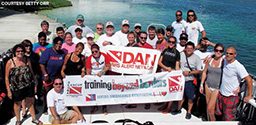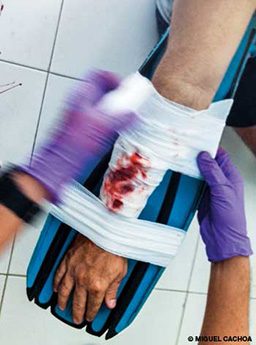I started diving in 1986, became a scuba instructor in 1999 and am now a proud DAN Instructor Trainer. I’m also the operations manager at Scuba Cancun Dive Center, which has allowed me to make a career out of something I love and am passionate about. Scuba Cancun was founded 33 years ago, making it the oldest dive center (and DAN Training Center) in Cancun and the Riviera Maya.
Recently, an opportunity presented itself when my friends Bill Hillermeier, a DAN Instructor Trainer (and my guru), and Tom Hurtado, general manager at Scuba Cancun Dive Center, approached me with a plan to expand our offering of DAN Education courses.
Sometimes it’s not easy to have buddies like these two — overachievers who are always up to something. Their latest idea was to offer DAN’s Diving Emergency Management Provider (DEMP) course to the Scuba Cancun Dive Center staff, but the idea quickly snowballed, ultimately becoming something much bigger: Training Beyond Borders.

The Training Beyond Borders Diving Emergency Symposium is the first program of its kind, offering DAN courses to firefighters, Red Cross personnel, civil protection emergency responders and National Marine Park rangers in the Yucatán — all with full scholarships. To achieve this extremely ambitious endeavor, a dream-team faculty was assembled. Dan and Betty Orr from DAN headquarters along with Brian Wake, director of DAN Education, worked side by side with DAN Examiners, Instructors and Trainers. DAN World representative Laura Johnson was instrumental in getting the local dive community involved. The event was a huge success; more than 200 DAN certifications were issued, and participants representing seven countries attended. With Provider-, Instructor- and Trainer-level certifications given for every DAN Education course offered, the Cancun/Riviera Maya region now has educators to disseminate DAN’s first aid and dive-safety courses throughout the region.
While we recognized the importance of our recent training, we never thought a true emergency would require our knowledge so soon. Only three short weeks after the event ended, our skills were tested.
A Bad Fall
A boat captain who rents space at a neighboring pier came into the dive shop one afternoon and advised the staff there was an injured person next door. A mechanic had fallen from a ladder and sustained an exposed fracture with heavy bleeding. One of our video staff members, Emmanuel Caballero, and National Marine Park Ranger Joel Ramirez, whose office is across the parking lot, jumped into action. Both these responders were scholarship recipients and graduates of Training Beyond Borders. This exact scenario had been discussed and even practiced during the DAN Basic Life Support: CPR and First Aid course.

Remembering their training, the two responders immediately grabbed first aid kits, donned gloves to protect themselves from blood-borne pathogens and began basic life support procedures. They brought the bleeding under control by applying sterile gauze and direct pressure. Then they immobilized the open fracture by splinting the arm using a scuba fin and covering the wound to reduce the risk of infection.
Tom Hurtado was the next person to arrive on scene. Because of a delayed response by emergency medical services and the severity of the injury, he decided to transport the injured mechanic to the hospital himself. One of the trained providers accompanied them and continued care en route.
At the hospital, a doctor told them that if first aid had been delayed, there was a high probability that the inured mechanic might have gone into shock due to blood loss and might have even died. Our plan of having trained providers around had already helped save a life.
A Toxic Sting
Scuba Cancun’s dedication to safety and decision to train its staff has also paid off on the water. Hugo Galvez, one of our divemasters who became a DAN Instructor at Training Beyond Borders, was soon called on to use skills from his DAN First Aid for Hazardous Marine Life Injuries course.
A diver came upon a lionfish during a dive. He took his eyes off the fish briefly while pointing it out to his dive buddy. At that moment, current and surge pushed the diver toward the reef and into the lionfish, which flared its spines defensively and inflicted several stings on the diver’s hand and fingers. In pain, the injured diver notified his divemaster, who ended the dive.
Back aboard the dive boat, Galvez took charge of the scene. The injured diver’s hand and fingers had already begun to swell, and the severe pain in the fingers and hand was now starting to travel up his arm. He was also experiencing nausea and an intense headache.
Following the protocols he learned in the DAN course, Galvez removed broken pieces of spine with tweezers, irrigated the wound with fresh water and cleaned it to remove debris. Next the injured extremity was immersed in a bucket of hot water, and the injured diver was monitored continually throughout the return trip.
Due to the severe pain, nausea, headache and potential for infection, the injured diver was taken to the emergency department upon arrival at the dock, and he received further evaluation and treatment by a physician. That diver has since returned to Scuba Cancun several times, and he always requests Galvez as his divemaster because Galvez’s training makes him feel safe.
We at Scuba Cancun Dive Center are thankful for our DAN training. At the start of the program, Hillermeier promised that when it was complete we would be confident in our skills and abilities. Watching a training video and being able to provide care in an emergency situation are two different things. Our training offered ample hands-on practice to allow us to become proficient. Hillermeier kept his promise. In both situations, the first-aid providers did not think twice; their training kicked in, they knew the proper course of action, and their responses were automatic.
Both the mechanic and the diver made full recoveries thanks to the quality programs created by DAN Education, presented by top-notch instructors and implemented by our newly trained, prepared and confident staff members. These positive outcomes are products of a true team effort.
© Alert Diver — Q2 Spring 2013